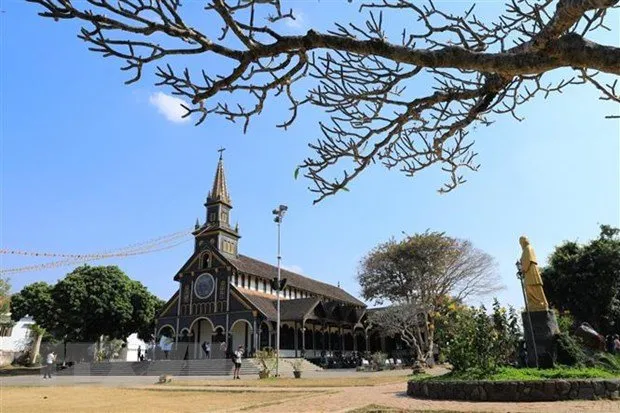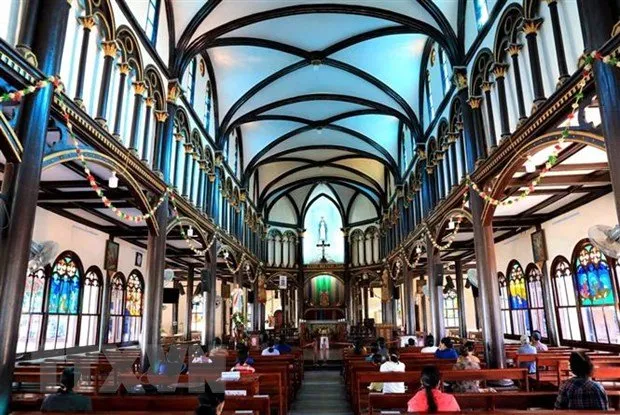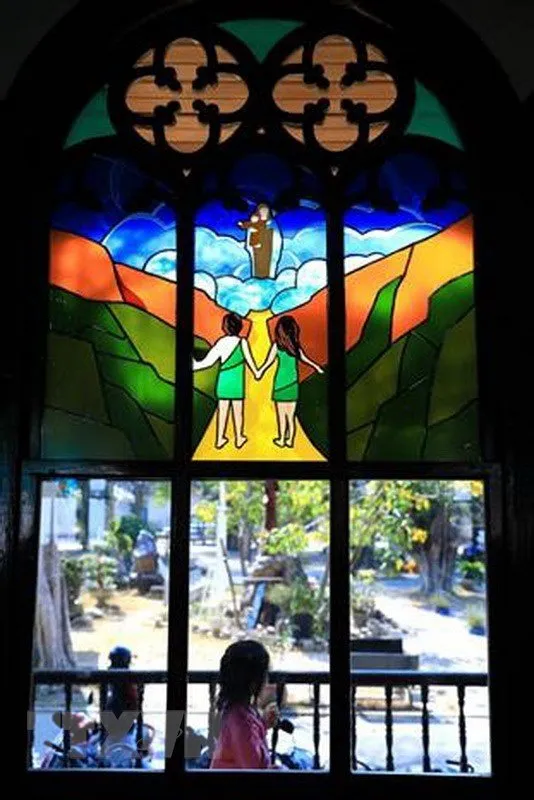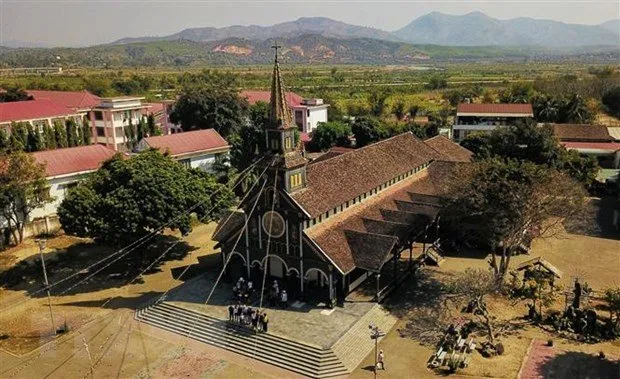Kon Tum Wooden Church, an architectural gem nestled in the heart of the Central Highlands, is not only a solemn religious structure but also a unique cultural symbol. It attracts visitors from all directions with its ancient beauty and a history spanning over a century. When visiting Kon Tum, you cannot miss the opportunity to admire this one-of-a-kind wooden architectural masterpiece, a convergence of Western architectural essence and indigenous cultural identity, offering meaningful spiritual and cultural exploration experiences.
The History of Kon Tum Wooden Church: Imprints of Time and Faith
To fully appreciate the beauty and value of Kon Tum Wooden Church, we need to journey back in time to its formation and development. The story begins in the 19th century when French missionaries arrived in Kon Tum, driven by the desire to spread their faith and establish the first religious facilities.
At that time, the legendary “Salt, Pottery, and Gong” route, a vital trade artery between the lowlands and the Central Highlands, became an important path for missionaries to reach and evangelize to ethnic minorities. From the first simple wooden and bamboo churches built in 1870 to the decision to construct a larger, more substantial church in 1913, all reflected the growth of the parish community and the vision of Father Joseph Décrouille, who laid the foundation for the Kon Tum Wooden Church we see today.
From 1913 to 1918, for five arduous years, hundreds of talented craftsmen worked diligently, overcoming numerous difficulties and hardships, including interruptions due to World War I, to create a magnificent wooden architectural work. “Cà chít” wood, a precious wood species unique to the Central Highlands, was chosen as the primary material, combined with traditional construction techniques, ensuring the church’s solidity and longevity for over a century.

The Unique Architecture of Kon Tum Wooden Church: Harmony of East and West
Kon Tum Wooden Church is not only unique for its construction entirely from wood, but also for its harmonious blend of Western Roman architectural style and the traditional beauty of the Ba Na people’s stilt houses. This is the special highlight, creating a one-of-a-kind architectural work deeply imbued with the cultural identity of the highlands.
From the outside, the church appears as a magnificent wooden castle, stately with the warm, deep tones of wood and tile, standing out against the green backdrop of the Central Highlands mountains and forests. The towering 4-story bell tower, the steeply pitched roof resembling a Rong house, the long, wide corridors with sturdy round wooden pillars – all combine to create a balanced, harmonious architectural ensemble with symbolic significance.
Stepping inside the sanctuary, visitors will be amazed by the vast, airy space filled with natural light. The high vaulted ceiling, the 12-meter-tall wooden pillars majestically supporting the entire structure, the intricate arched wooden truss system – all create a beauty that is both solemn and magnificent, leaving anyone who enters feeling awestruck.
In particular, what makes the uniqueness and artistic value of Kon Tum Wooden Church is the construction technique entirely using mortise and tenon joints, without using any nails. Wooden structural parts are connected delicately and firmly, demonstrating the master craftsmanship of ancient artisans. The ceilings, walls, and partitions of the church are plastered with traditional straw-mixed earth, further enhancing the closeness, rustic charm, and Vietnamese character of this architectural work.

Discovering the Inner Beauty of Kon Tum Wooden Church: Light and Color
Not only impressive with its exterior architecture, the inner beauty of Kon Tum Wooden Church is also a special highlight, captivating visitors with the shimmering, magical interplay of light and color. The stained-glass windows designed in the vitraux style, with drawings of biblical stories, not only serve to bring in light but also create a vibrant, lively space when sunlight shines through.
The large circular stained-glass window placed in the center, right above the main door, is a unique artistic highlight, showcasing the creativity and sophistication of the ancients. When sunlight shines on it, the painting reveals vivid images of the life of the ancient Central Highlanders, from scenes of villages, Rong houses, elephants dragging timber to rivers, streams, and majestic mountains and forests. This is not just a decorative detail but also a cultural symbol, representing the integration and intersection between indigenous and Western cultures.
The sanctuary, designed as a magnificent domed stage, is the holiest place in the church, attracting all eyes with its solemn and noble beauty. From the pews of the parishioners, looking up at the sanctuary, visitors will feel the reverence and sacredness of the worship space, while admiring the intricate and meticulous decorative details, reflecting the talent and dedication of the church builders.

Cultural and Spiritual Values of Kon Tum Wooden Church: A Spiritual Anchor
Kon Tum Wooden Church is not just a religious architectural work, but also a priceless cultural heritage, carrying profound historical, cultural, and spiritual values. With over 100 years of history, the church has witnessed many ups and downs of time, becoming an indispensable part of the cultural and spiritual life of the people of Kon Tum and a symbol of East-West cultural exchange.
For the Catholic community of Kon Tum, the church is a place for religious activities, prayer, seeking peace, and moral guidance. Solemn ceremonies and traditional religious rituals held at the church contribute to maintaining and promoting good cultural and ethical values in the community.
For visitors from all over, Kon Tum Wooden Church is an attractive cultural and spiritual tourist destination, offering unique and meaningful exploration experiences. Coming here, visitors not only admire the unique architectural beauty, learn about the church’s history of formation and development, but also feel the solemn, serene atmosphere, find peace in their souls, and learn more about the culture and people of the Central Highlands.

Travel Tips for Kon Tum Wooden Church: Time, Transportation, and Notes
To have a complete and meaningful trip to Kon Tum Wooden Church, visitors should note the following information and tips:
Visiting Hours: The church is open year-round, every day of the week, except in the evening. However, if visiting on Sunday, visitors should arrive after 9 am to avoid interfering with the parishioners’ Mass. The ideal time to visit the church is in the early morning or late afternoon, when the sunlight is soft, creating a beautiful and romantic scene.
Transportation: Kon Tum Wooden Church is located right in the city center of Kon Tum, very convenient for transportation. Visitors can easily get here by motorbike, car, or taxi. If traveling by motorbike, you can combine visiting other tourist attractions in the city and surrounding areas.
Notes: When visiting the church, visitors should dress politely and modestly, maintain order and general hygiene. If you want to take photos, you should ask for permission first and avoid making noise or disturbing the solemn atmosphere of the church. In addition, during major holidays, the church is often very crowded, you should arrive early to be able to comfortably visit and admire the beauty of this unique architectural work.
Tourist Attractions Near Kon Tum Wooden Church: Discovering the Colorful Kon Tum
Kon Tum not only has the Wooden Church but also many other attractive tourist destinations, visitors can combine visits to fully explore the beauty of this highland region. Some notable destinations near Kon Tum Wooden Church include:
- Kon Klor Suspension Bridge: The longest bamboo suspension bridge in Vietnam, a symbol of Kon Tum, where visitors can admire the poetic Dak Bla River and learn about the culture and life of the Ba Na ethnic people.
- Kon Klor Rong House: The largest traditional Rong house in the Central Highlands, preserving the cultural and spiritual values of the Ba Na people, with unique architecture and a distinctive cultural space.
- Pa Sy Waterfall: Majestic waterfall with pristine, magnificent beauty, located in the Mang Den ecotourism area, where visitors can immerse themselves in fresh nature and enjoy the cool air.
- Kon Tum Prison: Historical site marking the heroic revolutionary struggle years of the nation, where visitors can learn about history and commemorate the heroic martyrs.
- Kon Tum Museum: A place to display and introduce the history, culture, and people of Kon Tum, helping visitors better understand the land and people here.

Conclusion
Kon Tum Wooden Church is not only an attractive tourist destination but also a precious cultural heritage, a symbol of Kon Tum and the Central Highlands. With its unique architecture, long history, and profound cultural and spiritual values, the church deserves to be a must-visit destination in the journey to explore the majestic highland region. Come to Kon Tum and admire the beauty of this wooden architectural masterpiece for yourself, to feel the cultural exchange, find peace in your soul, and discover interesting things about the land and people here.